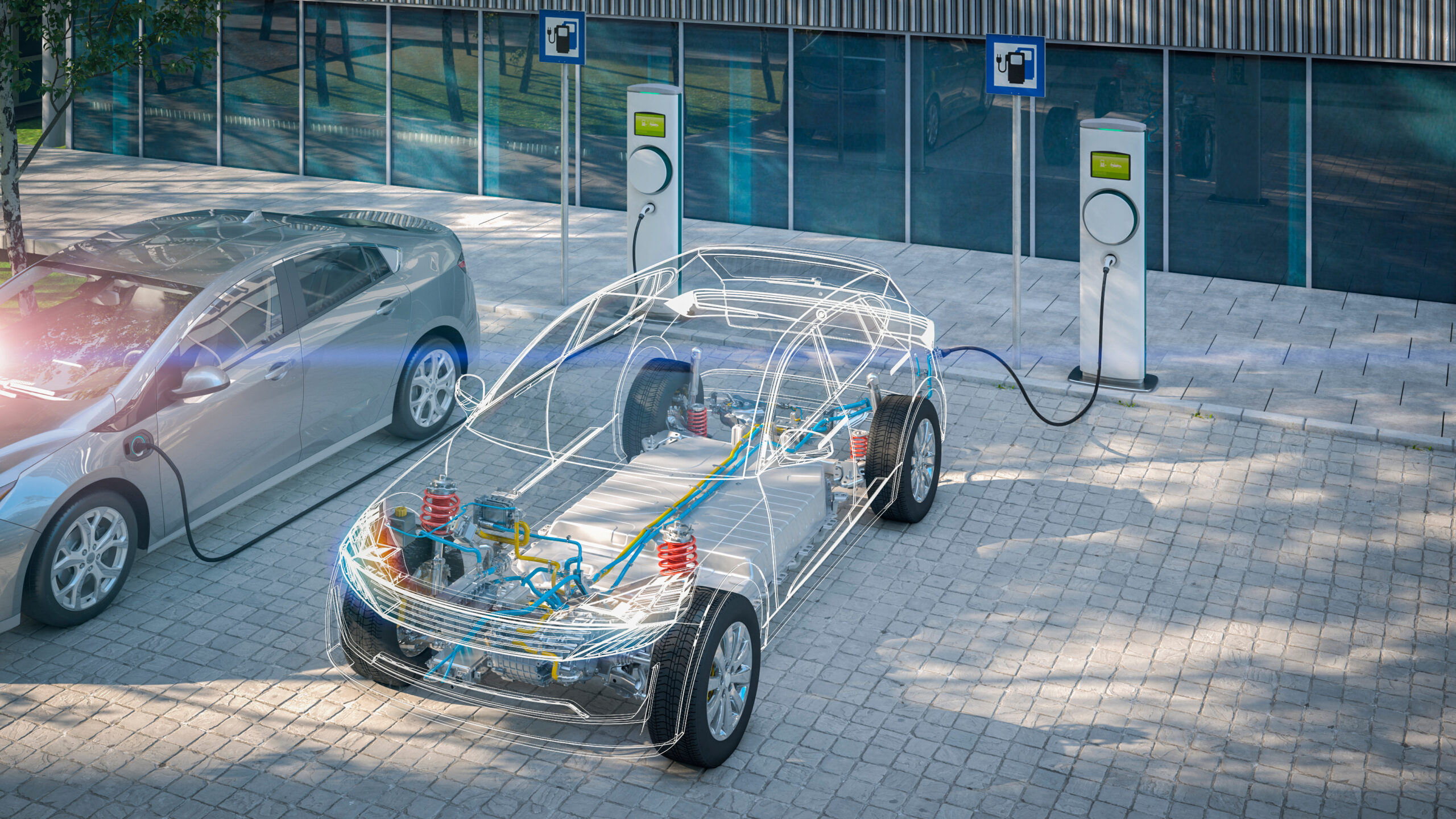12/04/2022
Background
Although electric motors have existed for over 100 years, they remain one of the most important pieces of technology in modern industry. This importance is reflected in the electric motor market; global electric motor sales were valued at USD 142.7 billion in 2020, and are expected to grow at an annual rate of 6.4% from 2021 to 2028.
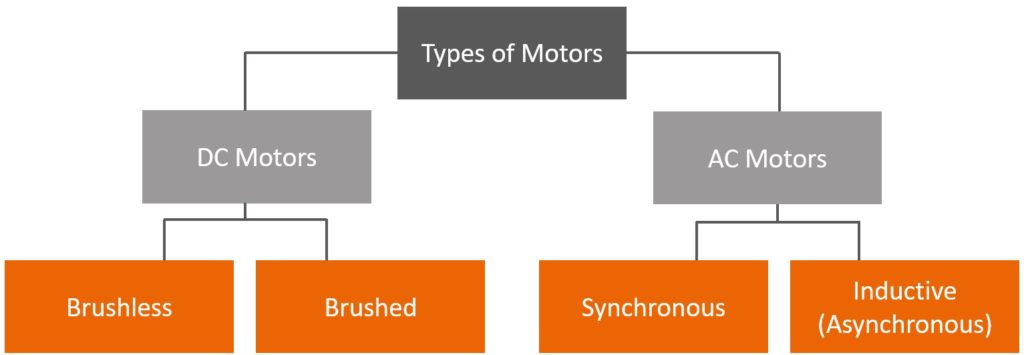
Electric motors play the important role of converting electrical energy into mechanical energy, and are divided into two main sub-types based on the power source used. DC motors are designed to be powered by a DC source, whereas AC motors are designed to be powered by an AC source. Within these sub-types, a vast range of different types of motors exist. This insight will be analysing some of the different types of motors currently used in industry, as well as looking at the activity in this area by analysing patent publication statistics.
DC Motors
DC motors utilise a DC power source to generate mechanical energy. They are typically split into two subtypes of motor based on the method of commutation used (i.e. how the DC power source is converted into an AC power source). These two subtypes are brushed motors (where a physical commutator is used to complete the circuit) and brushless motors (wherein commutation is performed by a controller and complex electronics).
i) Brushed DC Motors
Brushed DC motors are typically the simplest type of motor design. They normally consist of electromagnets on the rotor (the part of the motor that rotates), and permanent magnets on the stator (the part of the motor that is stationary). The electromagnets can be in the form of a current carrying wire. When the wire is placed in a magnetic field, the interaction of the current and magnetic field applies a force to the wire causing it to rotate.
If this were all the motor was made of, we would run into a problem. The wire would oscillate about, lose energy to friction, then come to a stop at some energetic minima; it would not effectively generate mechanical energy. This problem is solved by the inclusion of a physical commutator (e.g. a split-ring commutator). This causes the current inside of the wire to change direction, causing the wire to continue to rotate in the same direction.
The benefits of brushed DC motors are that they are relatively simple and cheap to implement. There are downsides however, mainly arising from the use of a physical commutator and brushes to complete the circuit. As the wire and commutator spin, they rub against the brushes that touch the commutator to complete the circuit. This not only leads to energetic losses due to friction, but also causes large amounts of wear on brushes, meaning they require frequent replacement.
ii) Brushless DC Motors
Brushless DC motors use the same principle of operation as brushed DC motors; they both generate motion via the interaction of rotor and stator electromagnetic fields. However, brushless DC motors place a permanent magnet on the rotor and a series of electromagnets around the stator. By switching these electromagnets on and off at the correct times, the stator magnetic field moves around the stator, which interacts with the rotor magnetic field and causes the rotor to rotate.
Instead of using a split ring commutator, brushless DC motors manipulate their stator magnetic fields using electronics to control what stator electromagnets are activated at what time. In general, this is performed by having the commutator electronics determine what coils should produce a positive, negative, or neutral torque to the rotor. Then, the commutator electronics apply a positive current to the positive torque coils, apply an opposite current to the negative torque coils, and switch off zero torque coils. This results in the rotor being continuously rotated in the same direction, improving the efficiency of the motor.
This removes the need for brushes, and therefore reduces the frictional energy losses. The downside of this approach is the increased cost due to the array of controllers and complex electronics required to precisely control the rotation of the stator magnetic field, as well as associated cooling requirements.
AC Motors
AC motors utilise an AC power source to generate mechanical energy. They are split into two main sub-types: synchronous motors and asynchronous (also called induction) motors.
i) Asynchronous / Induction Motors
In induction motors AC power is supplied to a series of electromagnets supported by the stator. These electromagnets encircle the rotor which contains conductor strips. The electromagnets are switched on and off in order to generate a rotating magnetic field relative to the rotor. This stator magnetic field induces currents in the rotor conductor strips, and these currents then produce a rotor magnetic field which opposes the stator magnetic field.
However, the stator magnetic field is rotating, meaning that in order to oppose it the rotor magnetic field must also rotate. This leads to a torque acting on the rotor causing it to rotate in the same direction as the stator field.
Induction motors are called “asynchronous” due to the fact that the rotor rotates at a lower speed relative to the stator magnetic field. This difference in speeds is what generates the torque on the rotor causing it to rotate.
ii) Synchronous Motors
Synchronous motors, whilst similar to asynchronous motors, do not experience a difference in rotor and stator magnetic field rotation speeds; they rotate at the same rate. This means that synchronous motors require additional equipment to start the rotor rotating, in order to initially get the rotor up to the stator magnetic field rotation speed.
Synchronous motors are more efficient when compared to asynchronous motors, but this comes at the cost of the synchronous motor being more complex and therefore more expensive.
Patent Publications
Patent filings and publications can be a useful gauge for analysing the amount of research going on in a given area; in general, an increase in investment and research in an area will lead to an increase in patent filings.
In addition, electric motor designs are often driven by compromises for specific applications or motor performance characteristics, leading to modifications that are ideal for patent protection.
Figure 1 shows the number of patent publications between 2010 to 2021 in Europe, the US, China, and Japan which have used the IPC code H02P – meaning the invention related to “CONTROL OR REGULATION OF ELECTRIC MOTORS, ELECTRIC GENERATORS, OR DYNAMO-ELECTRIC CONVERTERS… TRANSFORMERS, REACTORS, OR CHOKE COILS”.
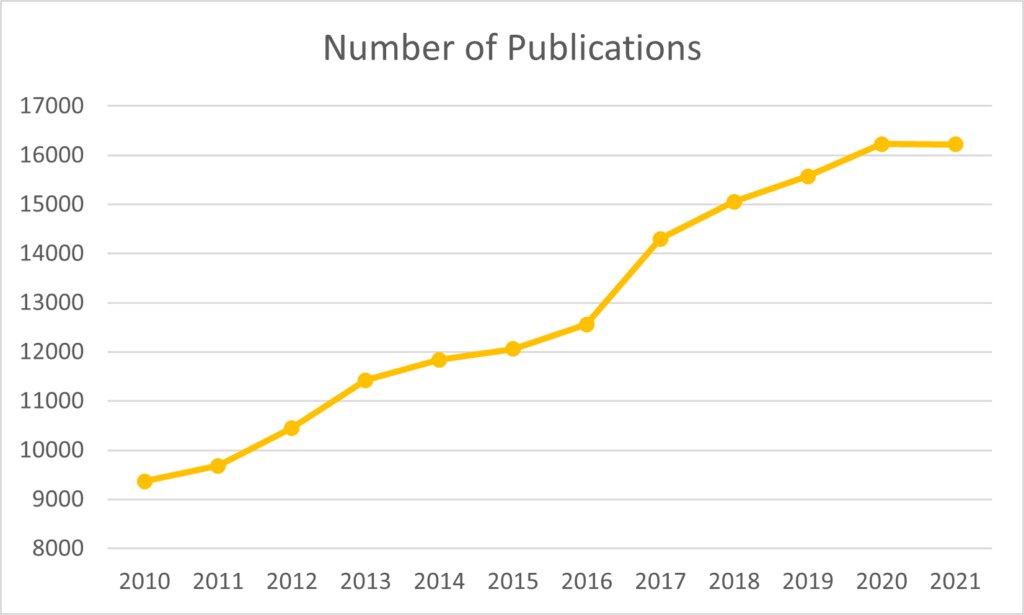
There has been a significant amount of growth in this technology area. Patent publications using code H02P have increased from 9,366 to 16,220 within just 11 years, an increase of over 73%.
These results show that not only is a large amount of research is being undertaken in this area, but that this research is being converted into (potentially) patentable ideas.
But who is carrying out this research? By looking at the number of patent publications owned by different applicants in Europe, the US, Japan, or China using IPC code H02P between 2010 and 2021, we can see who some of the biggest players are in these areas.
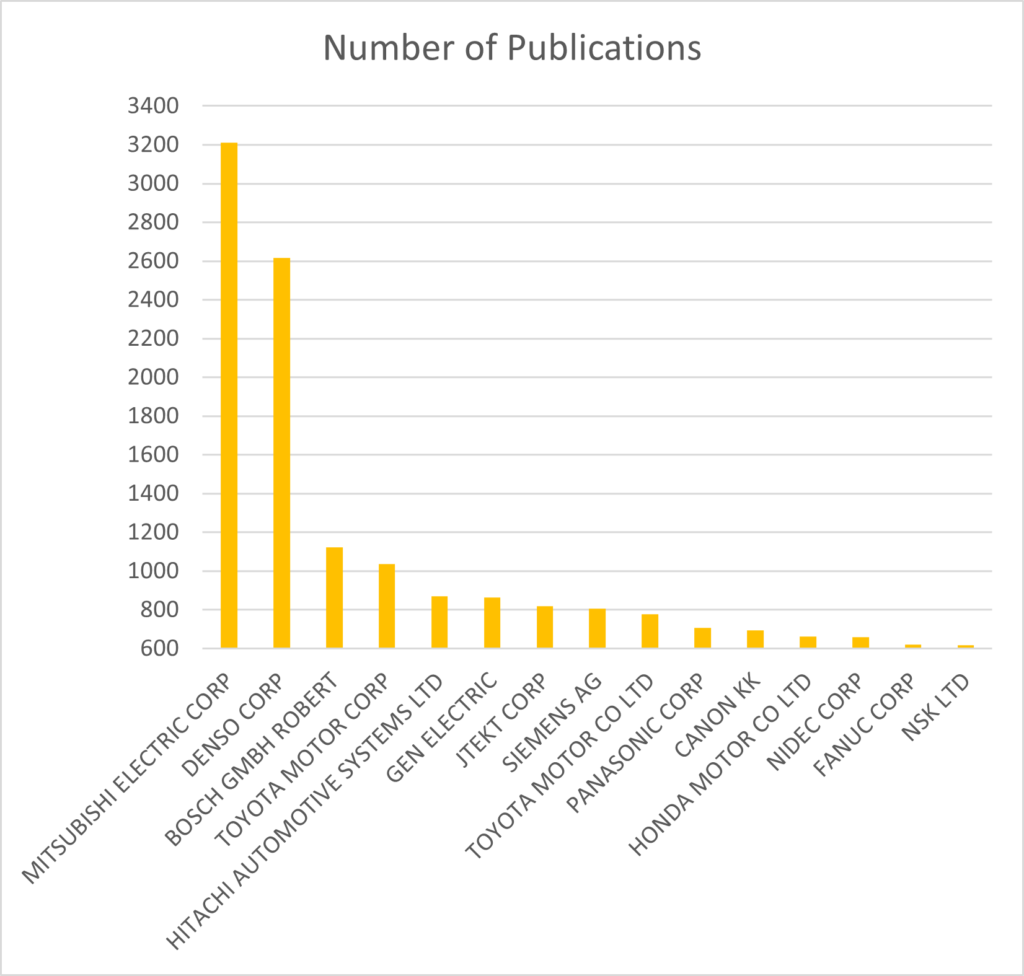
Of the top 15 companies with relevant patent publications in this period, twelve out of fifteen are Japanese companies, two out of fifteen are German, and one is American. Within this time period, Mitsubishi Electric Corp and Denso Corp played important roles within the marketplace; considering only the top 15 companies publishing in this area, Mitsubishi Electric Corp and Denso Corp accounted for an enormous 35% of the publications within this time period.
Both Mitsubishi Electric Corp and Denso Corp are Japanese companies. Mitsubishi Electric Corp was founded in 1921, and currently has revenues totalling over $34 billion. The company has a diverse range of products which include elevators, industrial robotics, rolling stock transportation systems, and automotive equipment. These different products give an indication of the highly varied applications of electric motors.
Denso Corp was founded in 1949, and currently has revenues totalling over $43 billion. In 2014, electric motors accounted for 7% of their global sales. Denso are also investing enormous amounts into motor related research, having recently opened the “Electrification Innovation Center” in Anjo, Japan. The center employs over 2400 people, and researches various electric vehicle technologies.
Zooming into the statistics and looking more recently from 2020 to 2021, the picture changes significantly however.
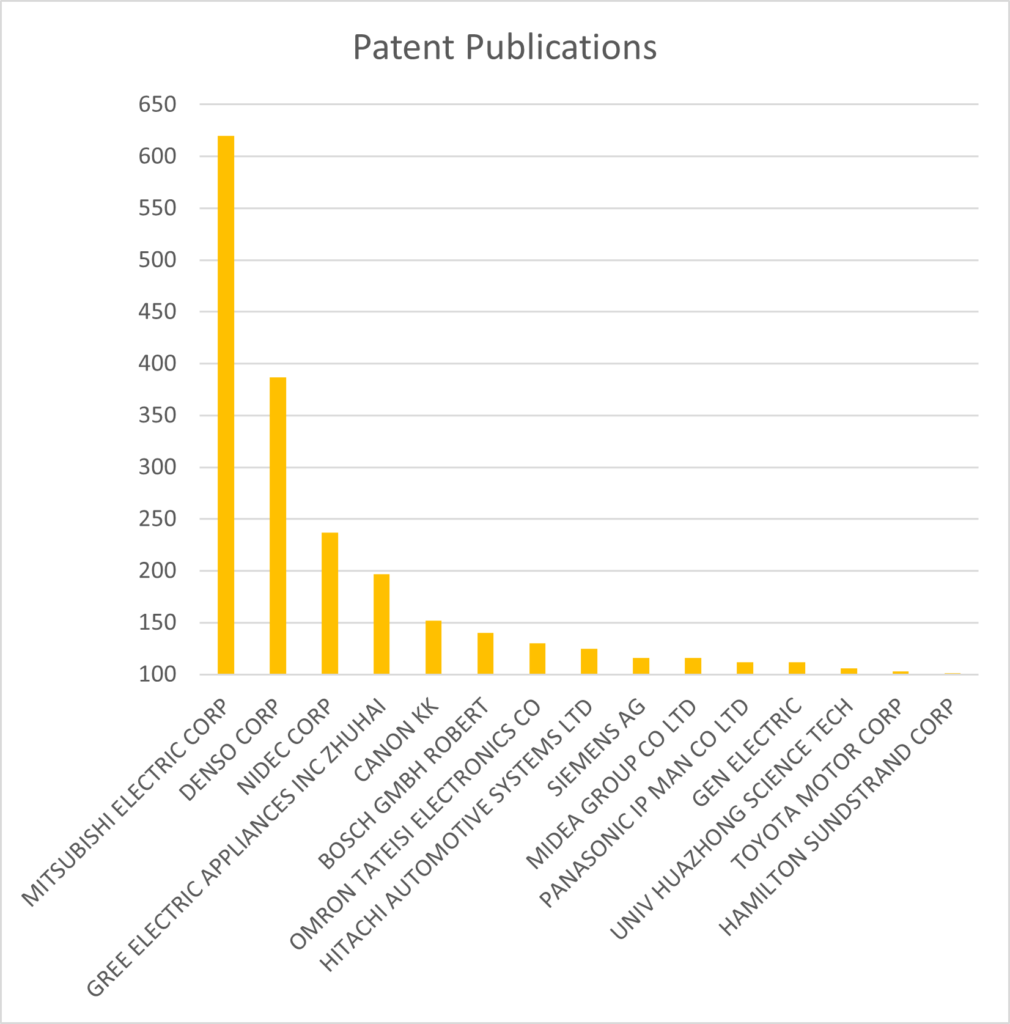
Now only eight out of the top fifteen companies are Japanese. Three out of fifteen are Chinese, two are German, and two are American. Whilst Mitsubishi Electric Corp and Denso Corp continue to lead the market, it is clear to see that an increasing number of Chinese companies are performing cutting edge research in this area and seeking to protect their intellectual property.
The Chinese company having the highest number of patent publications in this area is GREE ELECTRIC APPLIANCES INC ZHUHAI. They were founded in 1991 and currently have revenues totalling over $31 billion.
In conclusion, electric motors are one of the cornerstones of modern industry, and will continue to be a focal point for innovation as industries such as electric car manufacturing continue to grow. This is evidenced not only by the increase in patent publications in this area, but by the increasingly international range of companies looking to get involved in this technology area. Whilst this market is still dominated by Japanese companies, it is clear that companies around the world are seeking to invest and protect their intellectual property in this area. Over the next few decades, this sector will likely continue to see significant growth and research.
Reddie & Grose has a wide breadth of experience in drafting and prosecuting patent applications relating to electronics, software, and electric motor related inventions. If you have products in this space and are looking to obtain patent protection, or would like to discuss this or any of the content of this blog, please reach out to us.
This article is for general information only. Its content is not a statement of the law on any subject and does not constitute advice. Please contact Reddie & Grose LLP for advice before taking any action in reliance on it.
